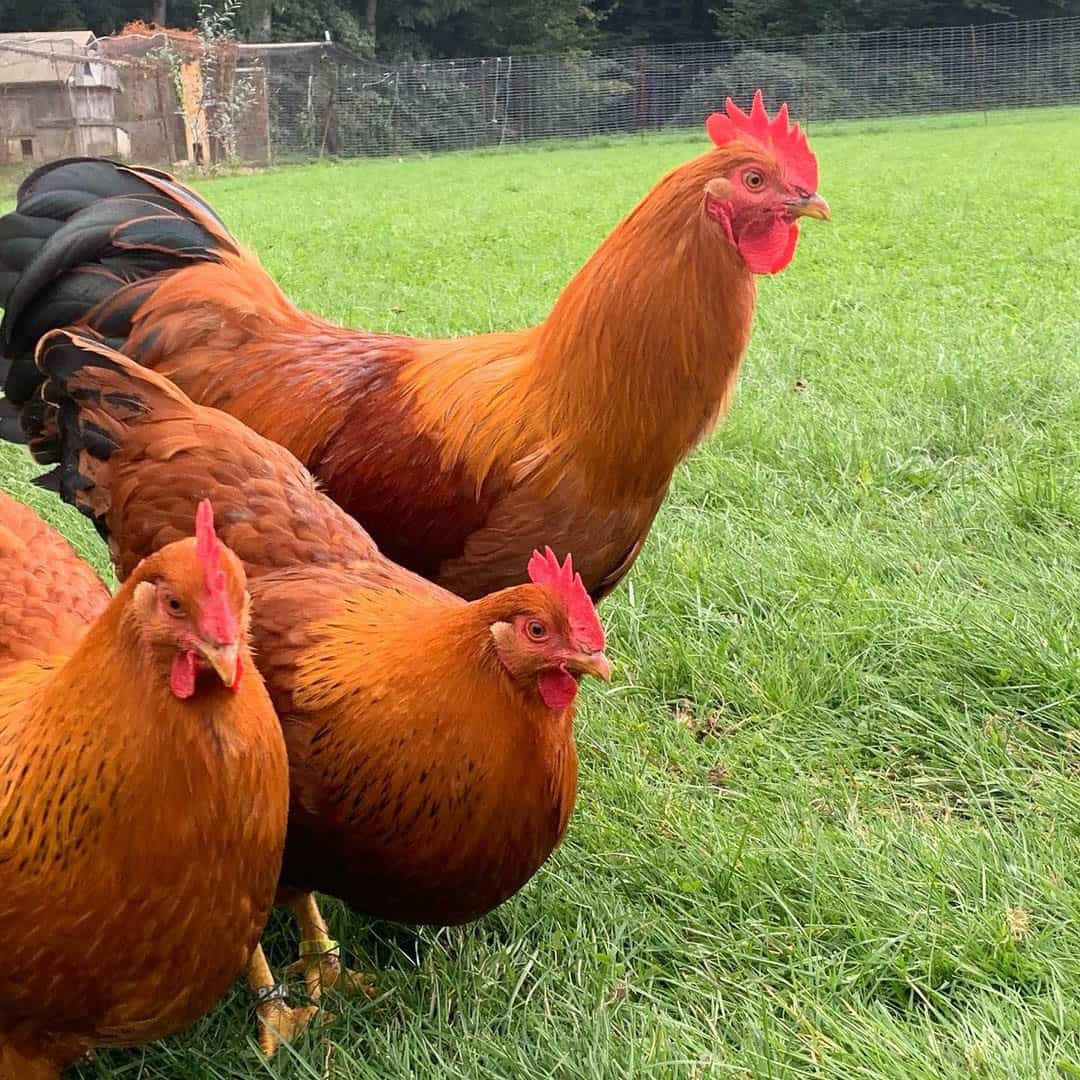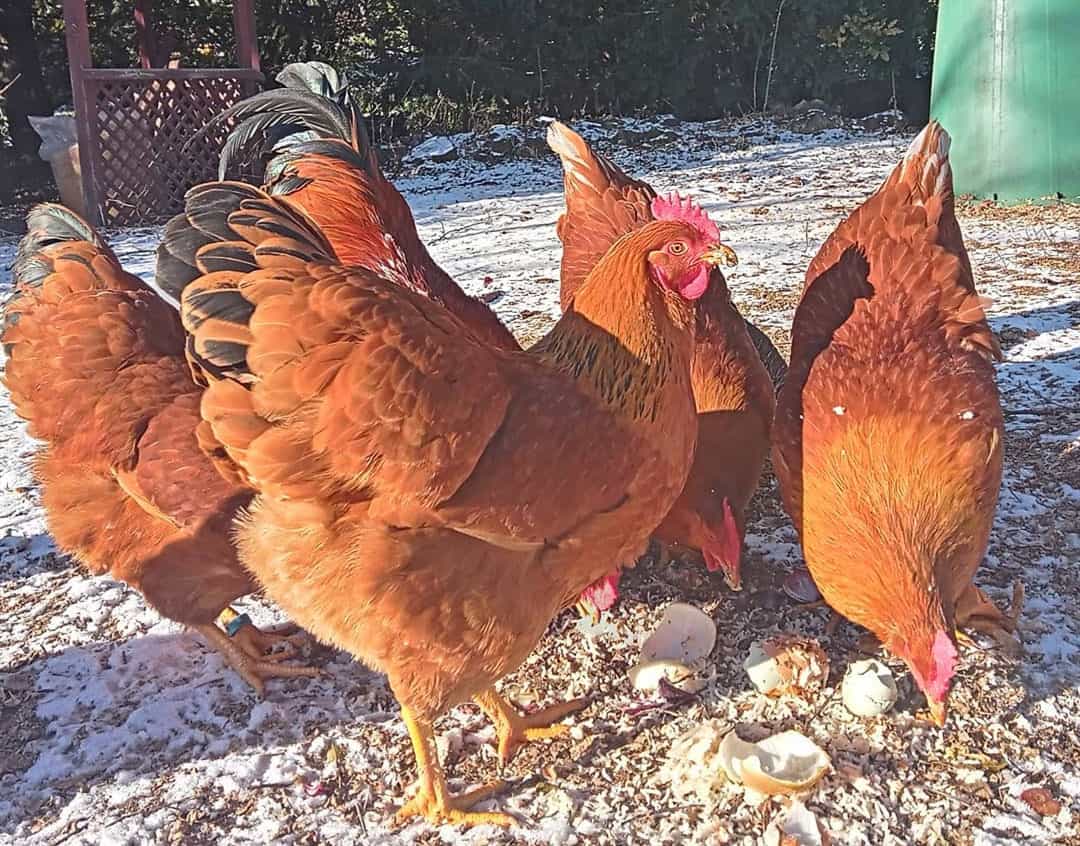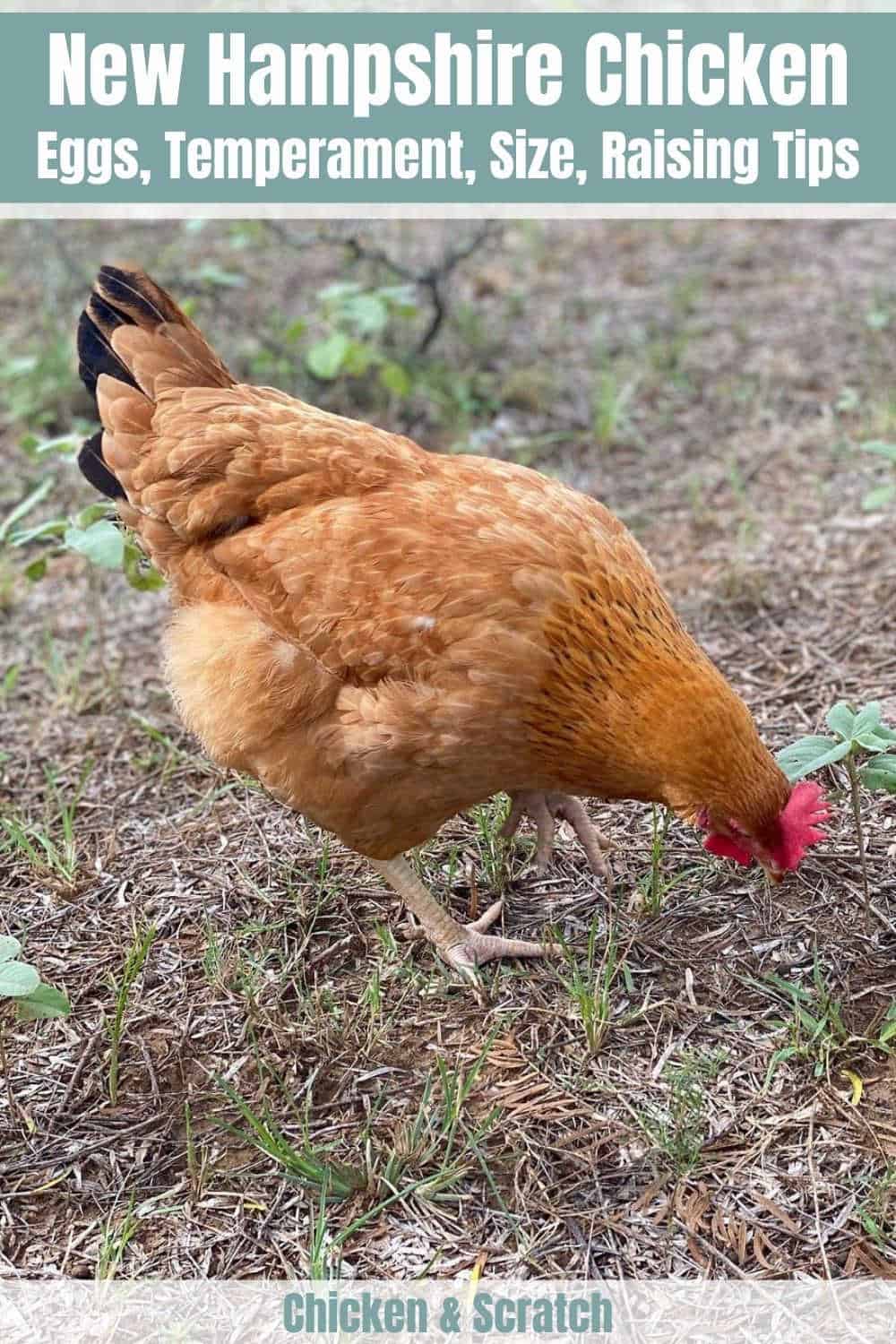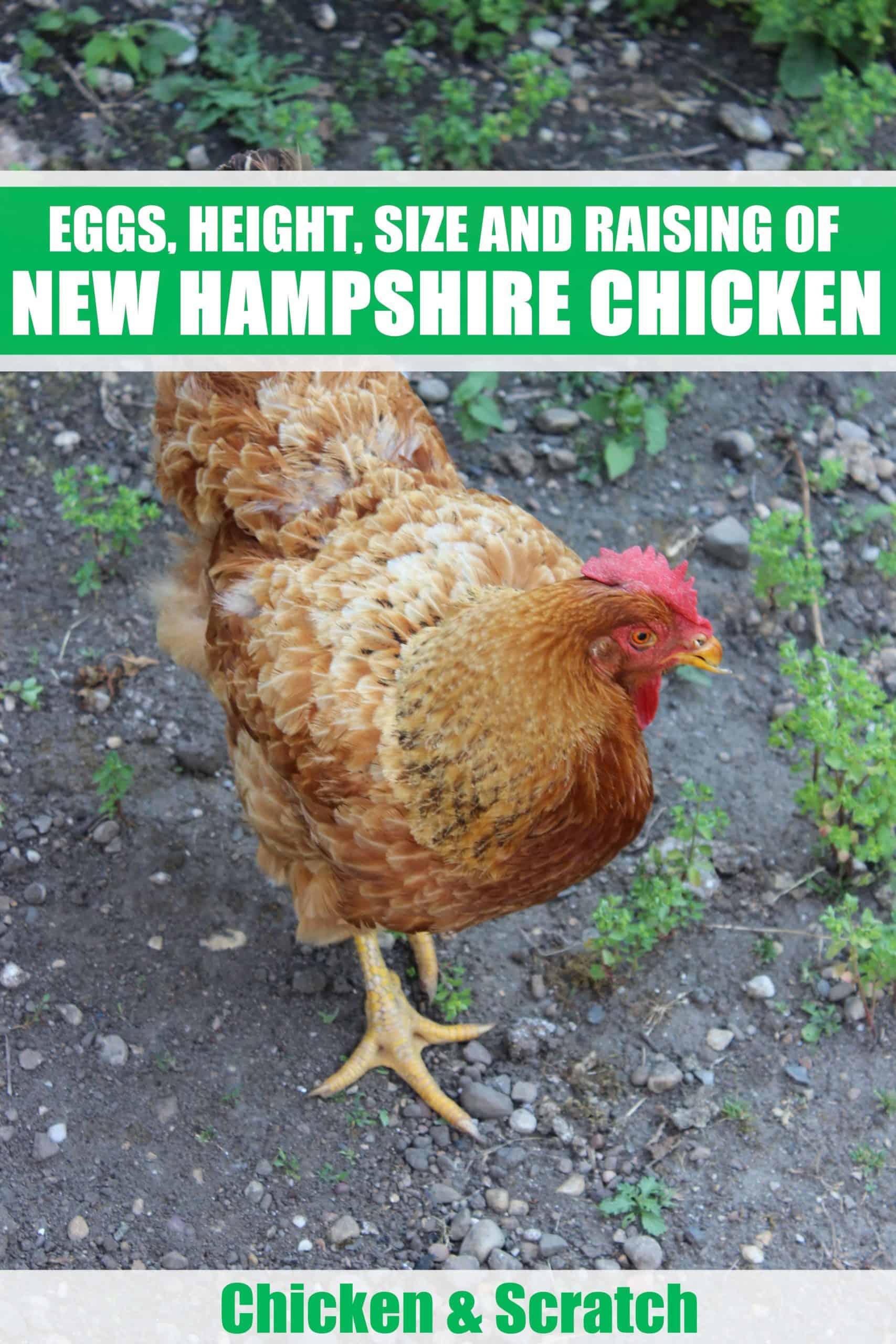The New Hampshire chicken is a beautiful relatively new breed of chickens. They have a distinct red-brown color. The New Hampshire chicken is often compared to the Rhode Island Red chicken and it is sometimes overshadowed by that breed.
The New Hampshire chicken is considered to be a dual-purpose hen. A dual-purpose chicken breed produces great eggs as well as substantial amounts of meat. The New Hampshire chicken is often overlooked, but it has a lot to offer.
New Hampshire Chicken Overview
| Attribute | Information |
|---|---|
| Purpose | Dual-purpose |
| Egg Color | Light Brown |
| Egg Size | Large |
| Broody | Yes |
| Heat Tolerance | Yes |
| Cold Tolerance | Yes |
| Comb Type | Single Red Comb |
| Egg Production | ~200 per year |
| Chicken Skin Color | Yellow |
| Life Span | ~7 years |
| Adult Weight | Hen: 6-7 lbs, Rooster: 7-8 lbs |
| Backyard Friendly | 5/5 |
New Hampshire Chicken Background and History

It is no coincidence why the New Hampshire chicken is often compared to the Rhode Island Red; they are connected to the same lineage. In the early 20th century, the New Hampshire chicken was created by crossing a strain of the Rhode Island Red chicken. The Rhode Island Red chicken was readily available in the New England area of the United States, making it easy to crossbreed.
A research scientist is credited with the formation of the New Hampshire chicken breed. A professor was working on Agricultural experimentation and wanted to work with the Rhode Island Red breed.
The breed was already great, but they wanted to do more selection for great egg laying and meat production. After careful selection, the New Hampshire chicken breed was created. This breed received its name due to the fact it was primarily developed in New Hampshire.
Twenty years after the development of the New Hampshire chicken breed it was accepted into the American Standard of Perfection. The New Hampshire breed is characterized by its capability to produce feathers fast, rapid growth, and early maturation.
The New Hampshire chicken has a rich history that is sometimes overlooked. The breed was used often by broilers and produced in large amounts in the United States. Also, the Delaware chicken breed was created from the New Hampshire breed. As of 2023, the New Hampshire chicken breed is the official poultry of the state of New Hampshire.
Now, the New Hampshire chicken breed is considered to be a great “starter” breed of chickens. They are a low maintenance breed that is easy to raise. This breed is also considered excellent for families with small children.
Breed Standard and Appearance

The New Hampshire chicken breed has a triangular body shape. It has a beautiful golden chestnut color. The feathers are vibrant, but they tend to change colors in sunlight.
If the New Hampshire chicken is exposed to sunlight for long periods of time their feathers will begin to turn a light red color. It took many years of selective breeding for the New Hampshire chicken to look differently from the Rhode Island Red chicken breed.
When the New Hampshire chicken breed finally had distinctive features from the Rhode Island Red chicken it was able to be individually classified. This process of selective breeding took about 20 years. The American Poultry Association recognized the New Hampshire chicken breed as a separate breed in 1939.
The New Hampshire chicken has the following classifications:
- The APA classifies the New Hampshire chicken as an American breed
- The Poultry Club of Great Britain classifies the New Hampshire chicken as a heavy soft feathered breed
- The American Bantam Association classifies it as a clean legged and single comb breed
Distinct Feathers
The feathers on the neck of a New Hampshire hen have black tips. The tail feathers also have this distinct feature. The overall feather color of this breed ranges from a bright chestnut orange/red color to a darker chestnut color. The feathers under the cage of the New Hampshire hen is a salmon pink color.
The body of the New Hampshire hen is broad and deep with a round physique. The body stature of this breed is often referred to as “meaty and plump.” Although it is a direct descendant from the Rhode Island Red chicken, the New Hampshire chicken’s feather coloration and positioning are different.
The Rhode Island Red chicken has a darker reddish-brown color and the New Hampshire chicken has a golden color with yellow highlights.

Specific characteristics of the New Hampshire chicken:
- Single red comb
- Floppy comb
- Red earlobes and wattles
- Orange eyes
- Reddish color beak
- Yellow skin
- The shanks and toes are yellow
- The shanks are clean, and they have a red line
The New Hampshire chicken weighs 6 – 8 pounds. There is a bantam version of this breed available. The bantam weighs between 30 – 34 ounces. There are two additional varieties of the New Hampshire chicken:
- Blue Tailed New Hampshire Chicken
- White New Hampshire Chicken
The blue-tailed New Hampshire chicken is extremely rare. It was created in Holland. The white New Hampshire chicken is lovely but also very rare. The original New Hampshire chicken breed is still common in the United States.
Personality and Temperament

The New Hampshire chicken is a nice gentle breed. They are easy to handle, and they don’t object to human interaction or being held. This is a family-friendly breed.
The New Hampshire chicken does well around children. Their temperament remains constant throughout the year. The only time they present aggressive behavior is when fighting for food.
Cold weather does not affect the New Hampshire chicken breed. This is one of the great features attributed to their birthplace. In fact, it has been known that New Hampshire will go out in freezing temperatures.
The breed can maintain in cold weather, but they prefer a nice warm housing environment. If the weather is cold outside, the breed does well if the coop is warmer.
The personality of the New Hampshire chicken is docile. They are a gentle breed that makes for the perfect beginner chickens and they are not difficult to breed.
Egg Laying
The New Hampshire chicken is a dual-purpose chicken. It is both an excellent egg layer and a meat producer. The New Hampshire hen can lay around 200 large eggs per year. The eggs are tinted light brown. On average, the New Hampshire hen can be expected to lay 3-4 eggs per week. The hen produces the most eggs during the winter months of the year.
The New Hampshire hens can go broody on a frequent basis. They make excellent mothers and they are also good setters. When some New Hampshire hens go broody they have been known to willingly accept and care for other chickens under them.
It is noted that the New Hampshire chicken was selected more for meat production. It was crossed more with other breeds that were known for producing large amounts of quality meat. The meat from New Hampshire chickens is used frequently as broilers or roasters.

Health Issues and Care
The New Hampshire chicken is a sturdy, strong, and robust breed of chicken. They have no specific diseases or major problems noted to their breed. Their life expectancy is around seven years.
It is important to be vigilant of the following parasites that can affect New Hampshire chickens.
- Mites can cause anemia in chickens. They use the chicken’s blood as food. If the comb of your chicken changes colors or they become weak, this is a sign they may be affected with mites.
- Bedbugs affect chickens as well. Like any parasite, they eat away at the blood supply of chickens. This can severely damage or kill a chicken. The best way to avoid bedbugs is to regularly keep the chicken coop clean. You should also use an approved chicken poultry duster.
- Fleas are a known chicken pest. Although they are small, they can be seen on chickens. Fleas are a brownish color. You will see an influx of fleas during warm weather months. It is recommended to regularly check for flea infestations.
- Also, if the New Hampshire chicken will be kept in cold environments use the following care tips:
- Check for frostbit often. Even if the breed can withstand cold temperatures there is still a chance for frostbite. To treat frostbite, you should immediately move the infected bird to a warmer area. Next, gradually warm the infected area. Frostbite causes circulation to cease. Warming up the area will help to return to normal circulation. Make sure the bird is drinking water and staying hydrated.
5 Tips for Raising New Hampshire Chickens

- It is suitable to keep New Hampshire chickens together. They are friendly and get along well.
- New Hampshire chickens can withstand warmer temperatures, but they need shaded areas to rest in.
- Keep the coop warm during the winter months.
- New Hampshire chickens like free-range. Limit confinement/
- Use quality feed with protein to ensure better meat and egg quality.
- Increase the diet of New Hampshire hens during colder months, as they still maintain good egg production during this time.
Summary
Even though the New Hampshire chicken breed sometimes lives in the shadow of the Rhode Island Red, it has proven to be a special breed all by itself. The New Hampshire chicken and its beautiful plumage have been a staple in the United States.
It is commonly known for producing excellent broiled and roasted meat. In most recent years, the New Hampshire chicken is finally receiving the honor it deserves.


Joseph Hudson has been raising chickens for over 15 years. In 2018, he completed the Agriculture & Natural Resources program at Mt. San Antonio College. He currently raises over 1400 chickens on his 7.5-hectare farm. He keeps sharing his experience on raising healthy and happy chickens on Chicken Scratch The Foundry.







